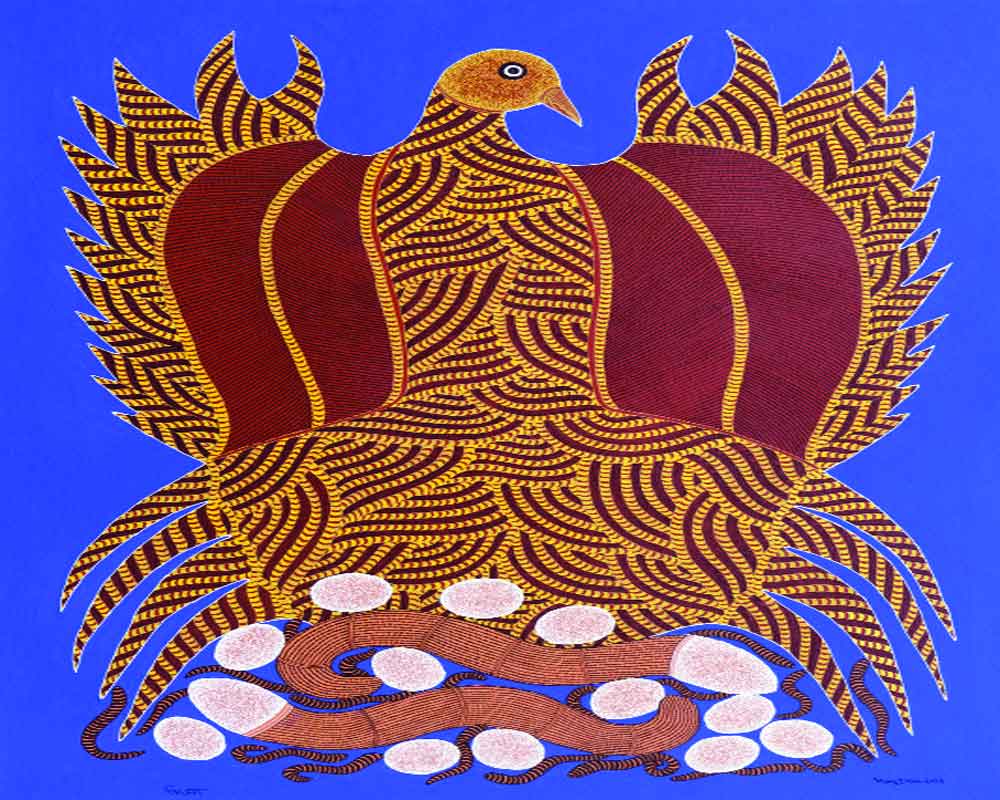Artist Bajju Shyam’s works tread the path of surreal and divine stories from the forests of the Gond tribe. By Uma Nair
I had been keen on looking at Padma Shri artist Bajju Shyam’s artworks because I consider him to be the finest artist after his uncle, late Jangarh Singh Shyam. And his series of artworks, titled Message From Trees, currently exhibited at the Ojas Art Gallery, are indeed a delight to behold. Bajju used to assist his uncle and now has inherited a finer and subtler sense of detail. His works tread the path of surreal stories in the forests of the Gond tribes.
The term Gond comes from the Dravidian expression kond, meaning ‘the green mountain’, which quite aptly depicts the close kinship with nature that the tribals maintain in all aspects of their existence. The forest and its many beings become an integral part of their visual representations — a cultural entity, visible through the variety of vibrant depictions painted on the walls of their homes.
While the Gond artists earlier used vegetable and mineral dyes, charcoal, coloured soil and other traditional things, their modern mode of painting has seen the use of acrylics and canvasses and large-sized sheets of watercolour paper. Bajju’s four compositions involve the local flora, fauna and the hidden tales of gods.
Mitrata
Mitrata (friendship) is a painting of the gorgeous plumed eagle-like bird, with snakes and its eggs at the foot of the composition. It is a versatile and emotive tale that takes us back to many legions. One of the many tales that Bajju had shared in the past was of Lord Shankar.
“When Shankar bhagwan, the creator, made the first man, there wasn’t a single leaf on earth. The man said, ‘Lord, what will I eat? How will I survive?’ The creator pulled three hair from his own body and through them, made three great trees. Then the man said, ‘But Lord, there are no fruits on these trees. Three will remain three, and they must die one day.’ Then Lord Shankar took the ash, coated his hair and sprinkled the trees with it. And flowers and fruits began to blossom on the trees. So during the time before we knew how to cultivate grains and crops, fruits on trees helped fill our stomachs. Here, I am just telling one of those stories,” says Bajju, who has created six eggs, which symbolise the co-existence of Neel Raja, and the entire world.
The artwork also echoes the beauty of birds. We don’t have to be told that birds are one of the most exquisite creatures on our planet. With a rich array of colours, a widely varying display of plumage and an unmatched ability to compose a symphony of songs and birds of all species, the work collectively captures our attention at once. One of the many ways that we appreciate our birds is by looking at paintings or photographs of them in the wild. Bajju recreates a magnificent bird in a composition that speaks of awe. However, the symbolism of birds has differed in different eras and regions. For Egyptians, a bird symbolises the soul, which is threatened in everyday idioms of life and nature’s mortality. Inspired from that, Bajju’s birds talk to us about harmony in living.
Tendu tree
Trees are central to the Gond tribal imagination. In addition to the stories that surround them, they are important in an everyday sense. There is a belief among the community that trees are busy during the day in giving shade and food to humans and animals. It is only during the night that their real spirit emerges.
Bajju’s drawing of the tendu tree and a bat has a tensile and tactile intricate beauty. “According to the ancient mythology of the tribe, during the day, trees nourish and protect and at night, they have a life of their own,” states Bajju. The spirits of these trees, with whimsical tales and beliefs, are brought out through this delicate illustration by Bajju. It’s uncanny how he poetically illustrates a particular aspect of Gond tradition related to the tree.
Mriga
Equally elegant is his deer painting, Mriga. Its intricate details can entice an art-lover — the leaf-like ear, the distinctly feminine slender-striped legs. In his weaving of the modern, fashionable elements, he gives us an image that is rare and unique. His use of fluorescent colours are at once subtle and the manner in which he creates its position and intensity is one of great poise. “I love the deer, I consider it the most beautiful animal,” says Bajju. “I find its whole body one of great grace. Its eyes are so beautiful. I have always felt that among all animals, it is a class apart because not only does it personify extraordinary beauty, it is the majesty and royal signature of the forests that make it an inspiration. After all, deer has been a part of literature and songs and poetry since time immemorial.”
(Message from Trees opens on August 2 and runs till September 1 at Ojas Art.)


























